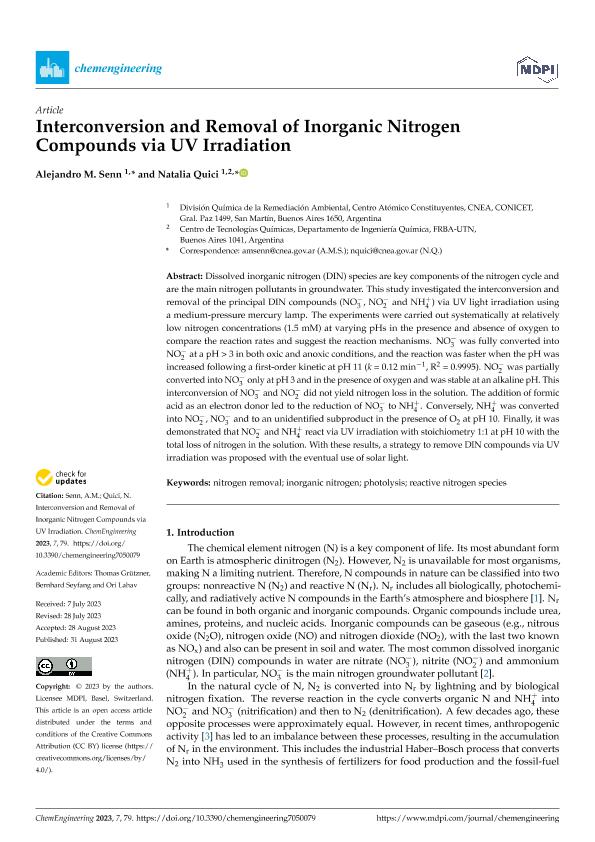Mostrar el registro sencillo del ítem
dc.contributor.author
Senn, Alejandro Marcelo

dc.contributor.author
Quici, Natalia

dc.date.available
2023-12-20T15:40:21Z
dc.date.issued
2023-08
dc.identifier.citation
Senn, Alejandro Marcelo; Quici, Natalia; Interconversion and Removal of Inorganic Nitrogen Compounds via UV Irradiation; MDPI; ChemEngineering; 7; 5; 8-2023; 1-11
dc.identifier.issn
2305-7084
dc.identifier.uri
http://hdl.handle.net/11336/220957
dc.description.abstract
Dissolved inorganic nitrogen (DIN) species are key components of the nitrogen cycle and are the main nitrogen pollutants in groundwater. This study investigated the interconversion and removal of the principal DIN compounds ((Formula presented.), (Formula presented.) and (Formula presented.)) via UV light irradiation using a medium-pressure mercury lamp. The experiments were carried out systematically at relatively low nitrogen concentrations (1.5 mM) at varying pHs in the presence and absence of oxygen to compare the reaction rates and suggest the reaction mechanisms. (Formula presented.) was fully converted into (Formula presented.) at a pH > 3 in both oxic and anoxic conditions, and the reaction was faster when the pH was increased following a first-order kinetic at pH 11 (k = 0.12 min−1, R2 = 0.9995). (Formula presented.) was partially converted into (Formula presented.) only at pH 3 and in the presence of oxygen and was stable at an alkaline pH. This interconversion of (Formula presented.) and (Formula presented.) did not yield nitrogen loss in the solution. The addition of formic acid as an electron donor led to the reduction of (Formula presented.) to (Formula presented.). Conversely, (Formula presented.) was converted into (Formula presented.), (Formula presented.) and to an unidentified subproduct in the presence of (Formula presented.) at pH 10. Finally, it was demonstrated that (Formula presented.) and (Formula presented.) react via UV irradiation with stoichiometry 1:1 at pH 10 with the total loss of nitrogen in the solution. With these results, a strategy to remove DIN compounds via UV irradiation was proposed with the eventual use of solar light.
dc.format
application/pdf
dc.language.iso
eng
dc.publisher
MDPI
dc.rights
info:eu-repo/semantics/openAccess
dc.rights.uri
https://creativecommons.org/licenses/by/2.5/ar/
dc.subject
INORGANIC NITROGEN
dc.subject
NITROGEN REMOVAL
dc.subject
PHOTOLYSIS
dc.subject
REACTIVE NITROGEN SPECIES
dc.subject.classification
Otras Ingeniería Química

dc.subject.classification
Ingeniería Química

dc.subject.classification
INGENIERÍAS Y TECNOLOGÍAS

dc.title
Interconversion and Removal of Inorganic Nitrogen Compounds via UV Irradiation
dc.type
info:eu-repo/semantics/article
dc.type
info:ar-repo/semantics/artículo
dc.type
info:eu-repo/semantics/publishedVersion
dc.date.updated
2023-12-19T23:23:40Z
dc.journal.volume
7
dc.journal.number
5
dc.journal.pagination
1-11
dc.journal.pais
Suiza

dc.description.fil
Fil: Senn, Alejandro Marcelo. Consejo Nacional de Investigaciones Científicas y Técnicas; Argentina. Comisión Nacional de Energía Atómica. Gerencia del Área de Seguridad Nuclear y Ambiente. Gerencia de Química (CAC); Argentina
dc.description.fil
Fil: Quici, Natalia. Comisión Nacional de Energía Atómica. Gerencia del Área de Energía Nuclear; Argentina. Consejo Nacional de Investigaciones Científicas y Técnicas; Argentina. Universidad Tecnológica Nacional; Argentina
dc.journal.title
ChemEngineering
dc.relation.alternativeid
info:eu-repo/semantics/altIdentifier/url/https://www.mdpi.com/2305-7084/7/5/79
dc.relation.alternativeid
info:eu-repo/semantics/altIdentifier/doi/https://doi.org/10.3390/chemengineering7050079
Archivos asociados
